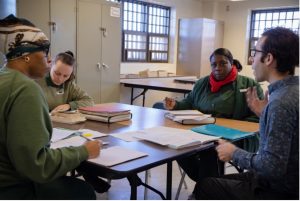By: Mary Hornschemeier Bandstra
Participating in a college program while in prison has been definitively shown to reduce recidivism, to improve financial outcomes for former inmates and their families, and to save significant taxpayer money. But for nearly thirty years, the primary vehicle prisoners would have used to fund that education – the Pell Grant – was cut off from incarcerated individuals. In the summer of 2023, that all changed.
The Benefits of Prison Education
Participation in prison education programs has been shown to provide benefits for students at any level of learning, from adult basic education to postsecondary and graduate-level work. These benefits include safer and less violent environments in prisons, safer work environments for prison staff, improved employment outcomes after release, and even improved health outcomes, especially for male inmates.
Prison education is very cost-effective, and all citizens benefit when correctional programming shifts toward education and away from punitive policies. In Illinois, for example, according to the Illinois Sentencing Policy Advisory Council, “each occurrence of recidivism costs that state an average of $151,662, which means that in five years recidivism will cost the state 13 billion dollars”. The Department of Policy Studies at the University of California, Los Angeles, found that “investing $1 million in prison education can prevent over 600 crimes, while the same investment in incarceration only prevents about 350 crimes”. This means that prison education is nearly twice as cost-effective as policies focused on punishment. In another study, a meta-analysis of prison education programs, researchers found that every dollar invested in prison education saves taxpayers four to five dollars in re-incarceration costs.

Caption: incarcerated students in a Bard Prison Initiative class Image used with permission from the Bard Prison Initiative
Government giveth and then taketh away: Pell Grants in prisons
In 1965, the United States Congress passed the Higher Education Act (HEA) of 1965, which created the Pell Grant program to fund postsecondary education for low-income Americans. Through the Pell Grant program, students could use grant funds to cover tuition costs at any participating postsecondary institution, including those housed in prisons.
The Violent Crime Control and Law Enforcement Act of 1994 (the “Crime Bill”) terminated Pell Grant eligibility for prisoners, eliminating a generation’s opportunity and progress. The Crime Bill’s effect was swift and disastrous.
According to the American Enterprise Institute, in the early 1990s, there had been approximately 772 college-in-prison programs housed in 1,287 prisons and jails across the United States. Without Pell Grants, however, postsecondary education opportunities for incarcerated individuals all but vanished: By 1997, only about eight programs remained.

Image credit: Elizabeth Lizzie. Courtesy of Pexels
This severe limitation in prison postsecondary educational opportunities persisted for nearly thirty years. The few programs that survived through this time were largely reliant on the financial backing of the universities that hosted them and on private donor support.
Availability of Prison Education Programs
In Illinois, as in many states, basic education and high-school level programs are significantly more common than college programs. While the Federal Bureau of Prisons requires educational enrollment for inmates who have not completed a high school diploma, state prisons generally do not have such requirements. More than two-thirds of incarcerated persons are housed in state or local facilities. This means that, for most incarcerated people, there is no requirement to participate in prison education of any sort. The allocation of funding and resources for prison programming reflects this lack of requirement. Currently, in Illinois there are thirteen colleges and universities that host postsecondary education in prison programs. Most of them are small programs that have long waiting lists and, before this academic year, have been entirely dependent on non-Pell grant funding.
The primary factors determining whether inmates in Illinois have access to postsecondary education at all are their geographic proximity to a university and that university’s access to private or outside financial support for prison education. Generally, inmates have little control over the location of their incarceration or the funding stream to support their education. Fortunately, current changes in federal funding for prison education and in state correctional education policy are creating opportunities to expand postsecondary prison education programs.

Incarcerated students in a Bard Prison Initiative class.
Image used with permission from the Bard Prison Initiative.
The Path Forward
The U.S. Department of Education launched the Second Chance Pell Experimental Sites Initiative (“Second Chance Pell”) in 2015. Second Chance Pell partnered 67 colleges and universities with prisons, allowing them to distribute Pell Grants to incarcerated students enrolled in approved college programs. In 2020, the Vera Institute of Justice conducted a four-year examination of the original 2015 Second Chance Pell program. A key takeaway from that study is that incarcerated students who participate in postsecondary education programs are forty-eight percent less likely to return to prison than those who do not.
On December 27, 2020, Congress passed the FAFSA Simplification Act (FSA). As the title implies, the FSA streamlined the complicated Free Application for Financial Student Aid form used by all postsecondary students, but the FSA also eliminated the prohibition on incarcerated Americans accessing Pell Grant funds, formally ending the disastrous policy that started in 1994.
The FSA went into effect on July 1, 2023. This means that, as of last fall, federal Pell Grant funds are accessible to incarcerated students across the country for the first time in a generation. The only limitation for incarcerated students to use Pell Grant funds is that they must be enrolled in a prison education program.
On November 15, 2023, the first group of graduates from the Northwestern Prison Education Program crossed the stage at their commencement ceremony. The sixteen graduates were the first incarcerated people to graduate from a top ten university. With Pell grant funding now available for incarcerated students, success stories like these should become more common, as correctional institutions once again shift more toward rehabilitation and learning and away from purely punitive policies.
As Amy Lloyd from the U.S. Department of Education, and Amy Solomon from the U.S. Department of Justice, called for in their July 2023 op-ed, now is the time for colleges and universities to embrace the opportunity provided by this update in Pell grant policy. Expanded college programming for incarcerated people is effective, productive, and economical. It is also undeniably the right thing to do to continue to reduce the population of Americans who are incarcerated.
Mary Hornschemeier Bandstra is a law student at Loyola University of Chicago Law School and wrote this blog post as part of the Education Law Practicum Course.

